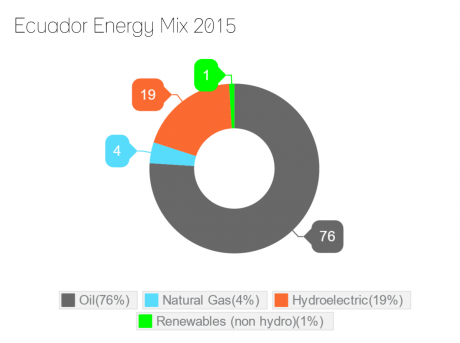Ecuador has a target to reach 60% renewable energy generation capacity by 2017, under the National Plan for Good Living 2013-2022, with a special emphasis on hydropower and bioenergy. From 2000 to 2015, Ecuador had a feed-in tariff system to support renewable electricity deployment. This has brought renewable power on the scene in Ecuador, except it still represents only 1% of the country's energy consumption. Ecuador’s oil dependence has not shifted in recent years. As shown in the chart below, Ecuador still relies on oil to meet 76% of its energy demand, only slightly down from 2005 figures of 82% 1.
One of the goals of the Yauni-ITT Initiative was to invest the financial contributions in renewable energy sources, to diversify energy supply and reduce dependency on fossil fuels. In the absence of this initiative, the challenge for Ecuador is to find funding to pursue renewable energy investment.

Data source: BP Statistical review of World Energy 2016
The government created the Galapagos Island Zero Fossil Fuels initiative to promote renewable energy projects and move away from oil. It aims to fully convert the archipelago’s energy supply to renewable energies by 2020. The initiative involves two wind farms, two solar PV projects and two hybrid PV-biofuel-battery projects.
One of the projects is ENERGAL, which ran from 2012-2015, with the aim of climate protection through the use of renewable energies on the Galapagos Islands, with special focus on power generation using jatropha oil. On Floreana Island, two converted generators that run on jatropha oil have been providing up to 100% of the island’s electricity from renewable energy since February 2011.
(1) BP Statistical Review of World Energy 2016
